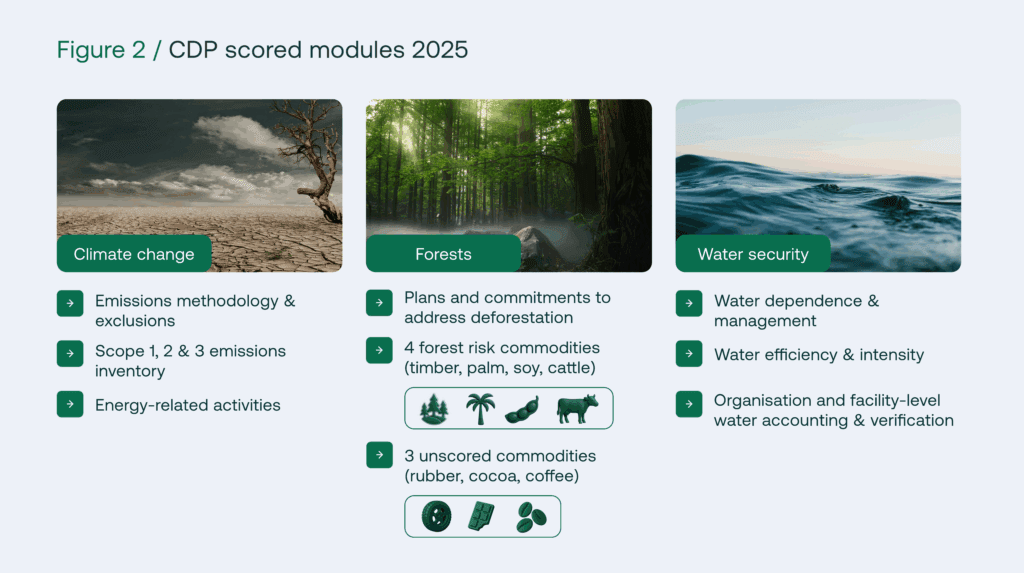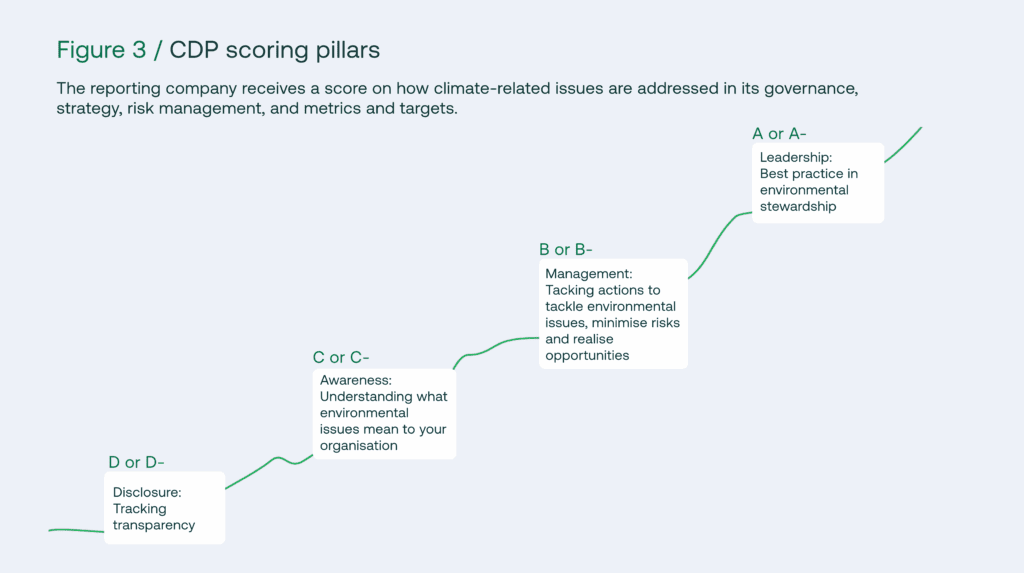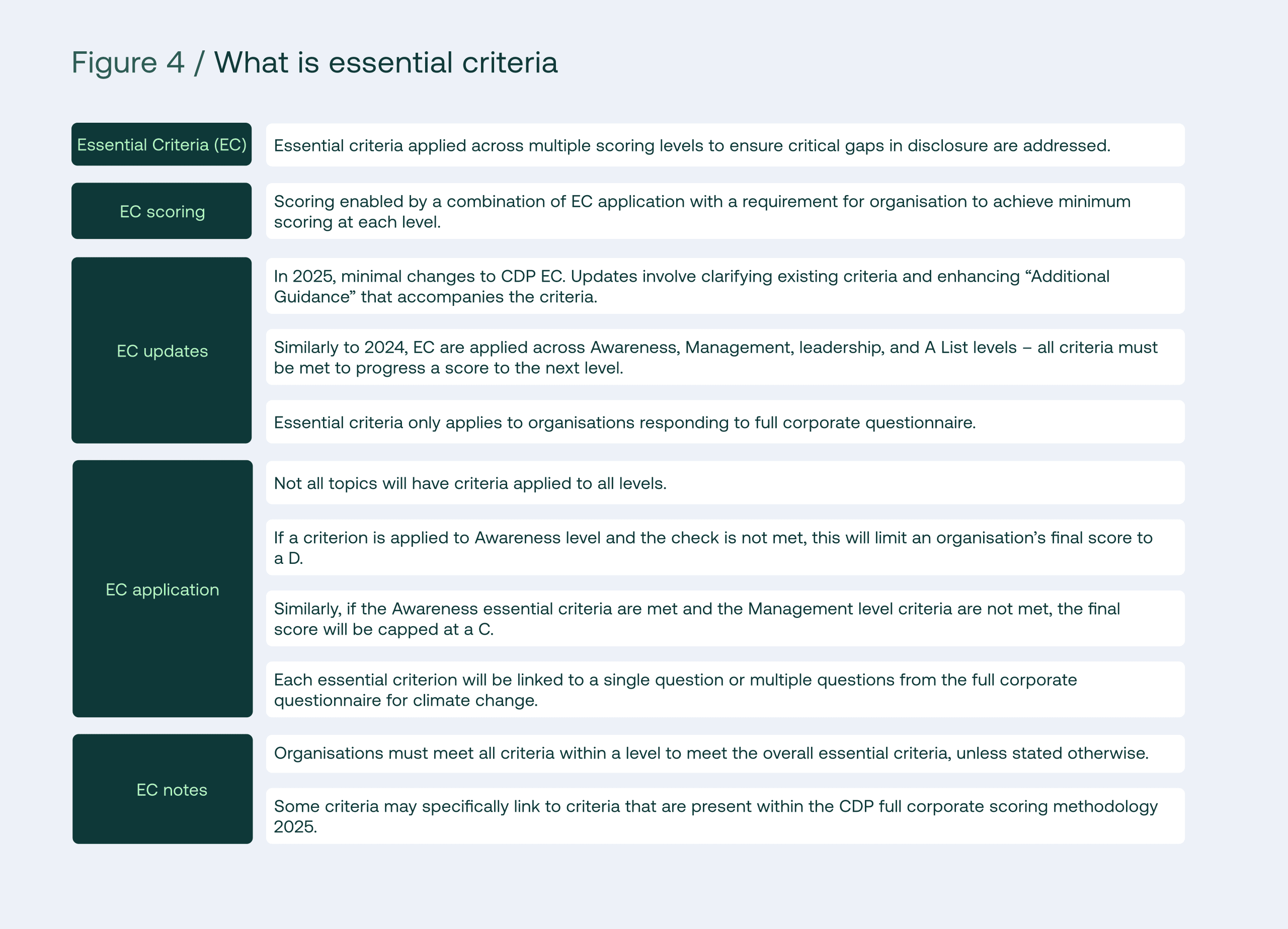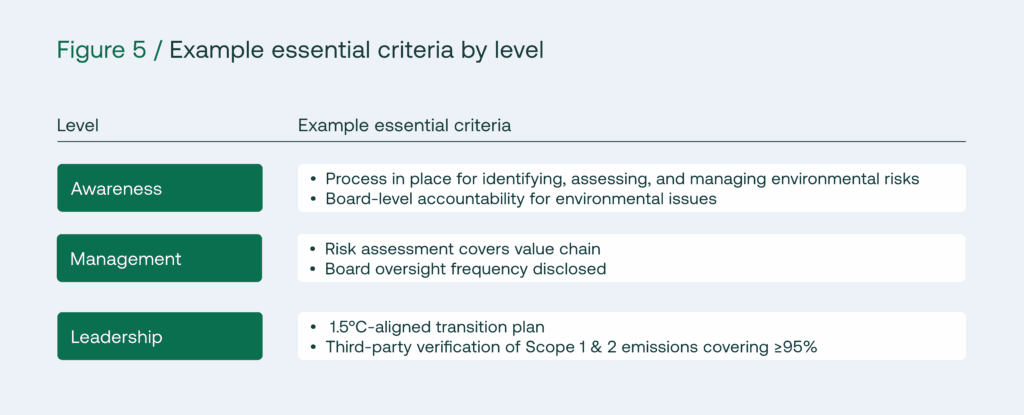 The business guide to nature-based vs. engineered solutions
The business guide to nature-based vs. engineered solutions
“CDP is no longer just a data repository; it’s become judge and jury—if you miss even one essential criterion, your score is capped, no matter how much else you achieve.”
The CDP has evolved from a voluntary data repository into a global benchmark for environmental transparency and action. In 2024, the CDP reporting framework expanded a new game-changer: Essential criteria. For 2025, these requirements remain at the heart of the scoring methodology and understanding them is now the single most important factor in securing a strong CDP score.

Companies worldwide are investing more time and resources than ever in their CDP disclosures. Even the most diligent organisations are seeing their scores capped or dropped—sometimes by multiple levels — if they miss just one essential criterion. Mastering the Essential Criteria is not optional; it’s the key to unlocking your full scoring potential and demonstrating true environmental leadership.

What are CDP’s essential criteria?
CDP’s Essential Criteria are a set of specific, non-negotiable requirements that organisations must meet at each scoring level—Disclosure (D), Awareness (C), Management (B), and Leadership (A). They apply to each theme (Climate Change, Water Security, Forests) and, crucially, to every scoring level—not just the top tier anymore.
Find more details in our video about essential criteria:

If you fail to meet all Essential Criteria for a given level, your score is automatically capped at the previous level, regardless of your total points or achievements elsewhere. For example, a company could excel in most areas and still be held at Awareness (C) if it misses a single Management-level Essential Criterion.
“It’s black and white, all or nothing. If you don’t comply with the Essential Criteria of the level above, you will be capped at the previous level.”

Why did CDP introduce essential criteria?
CDP’s shift to Essential Criteria reflects a broader trend: aligning with global regulatory frameworks (CSRD, ISSB, TNFD), increasing data reliability, and raising the bar for environmental stewardship. The new approach aims to:
- Ensure consistent, comparable disclosures across organisations and sectors
- Drive higher data quality and auditability
- Encourage companies to embed climate governance, risk management, and target-setting into core business strategy
- Facilitate benchmarking and comparability for investors, policymakers, and stakeholders

How essential criteria affect your score
The scoring “Gatekeeper”
Essential Criteria act as a series of gates. You must pass each one to progress to the next scoring level. Here’s how it works:
- Disclosure (D): Entry-level reporting; must answer all required questions.
- Awareness (C): Must meet all Awareness Essential Criteria (e.g., process for identifying and managing risks, board-level accountability).
- Management (B): Must meet all Management Essential Criteria (e.g., detailed risk assessment across the value chain, board oversight frequency).
- Leadership (A): Must meet all Leadership Essential Criteria (e.g., 1.5°C-aligned transition plan, third-party verification of emissions).
If you miss even one essential criteria at any given level, you remain at the previous level—no exceptions.
In a nutshell: At the Awareness stage, companies must both have a process in place for identifying, assessing, and managing environmental risks and opportunities (EC-CC1) and provide detailed evidence of that process. If either requirement is missing, the score is capped at Disclosure (D/D-).
Progressing to the Management level, the criteria become more specific: organisations must demonstrate that their risk management process covers direct operations, the upstream value chain, or the downstream value chain, and must also disclose how frequently environmental issues are addressed at the board or equivalent governing body (EC-CC1, EC-CC3).
If these are not met, the score cannot advance beyond Awareness (C/C-). For Leadership, the bar is set at having a 1.5°C-aligned transition plan, a plan with a different temperature alignment, or a credible plan to develop one within two years (EC-CC7). Without this, the score is capped at Management (B/B-).
The final slide reinforces that these criteria are non-exhaustive but essential: missing even one blocks advancement, regardless of performance elsewhere. This stepwise, visual approach underscores how CDP’s methodology ensures only organisations with robust, transparent, and board-supported climate strategies reach the highest scores.
Examples of essential criteria

Sector-specific criteria also apply, especially for Financial Services and Oil & Gas, which have unique requirements (e.g., low-carbon R&D details for Oil & Gas at Leadership level).
Trends and key topics in essential criteria
While the specifics vary by theme and sector, several topics consistently appear as Essential Criteria across CDP’s questionnaires:
- Public disclosure of environmental response
- Board-level governance and competency
- Risk and opportunity identification and management
- Science-based target setting
- Supplier engagement and value chain coverage
- No significant exclusions in reporting
Climate Change remains the most demanding theme, with Essential Criteria at both Awareness and Management levels, while Water and Forests apply most criteria at higher levels.
Application of EC from 2024 and later
- Stricter progression: Companies must now systematically address essential criteria at every stage, not just aim for the top.
- No skipping steps: Even high-performing companies can be held back by missing a single required disclosure at a lower level.
- Preparation & strategy: Organisations must conduct detailed gap analyses and ensure their data and processes meet the new, more granular requirements.
- Alignment & transparency: The changes drive greater consistency, comparability, and alignment with evolving global standards
Common pitfalls and how to avoid them
1. Not knowing the criteria in advance
Many companies were unaware of the Essential Criteria until after submission, leading to unexpected score drops. Always download the latest Essential Criteria checklist from CDP’s resources before you start.
2. Missing details in key questions
A single vague or incomplete answer (e.g., stating “Unknown” for risk likelihood) can block progression to higher levels. Provide both qualitative and quantitative details wherever possible.
3. Wasting time on non-scored questions
Focus your resources on questions linked to Essential Criteria and scoring. Some questions are “nice to have” but do not affect your score1.
4. Overlooking sector-specific requirements
Check if your sector (e.g., Financial Services, Oil & Gas) has additional or different Essential Criteria.
5. Lack of documentation or evidence
You may be doing the right things, but if it’s not documented or clearly described, it won’t count. Ensure all processes, board roles, and targets are well evidenced.
Practical steps to master essential criteria
1. Start early and map your gaps
Conduct a gap analysis against the Essential Criteria for your theme and sector. Identify missing processes, documentation, or data early in the year.
2. Tailor responses to your sector
Use CDP’s sector-specific guidance to ensure you’re meeting the right criteria for your industry.
3. Prioritise quality over quantity
Detailed, evidence-backed responses to Essential Criteria questions matter more than exhaustive answers elsewhere.
4. Prepare for third-party verification
For Leadership-level scores, ensure you have third-party verification of Scope 1 & 2 emissions (≥95%) using accepted standards (e.g., ISO 14065).
5. Document board involvement and competency
Clearly describe the roles, expertise, and frequency of board-level oversight on environmental issues.
Looking ahead: What’s changed for 2025?
- No major changes to Essential Criteria from 2024, but clarifications and improved guidance have been added for usability.
- Data migration features now allow you to carry over some previous responses but always review for new requirements1.
- CDP is expected to expand Essential Criteria to more themes and levels in future cycles.
Read more on CDP updates in 2025 from our blog article.
Why work with Nexio Projects?
At Nexio Projects, we’re a boutique sustainability consultancy helping organisations navigate complexity and build impactful, actionable strategies. With a team of 30+ specialists and generalists, we support companies across sectors to embed sustainability at the heart of their business. Recognised by Verdantix as a top 10 global ESG consultancy and a strategic EcoVadis partner since 2018, we combine technical knowledge with a hands-on approach that drives real results.
Our experts are particularly specialised in climate solutions, offering targeted support across key areas:
- Sustainability strategy: Define, develop and implement an integrated sustainability strategy with the dedicated support of our experts.
- Net zero & decarbonisation: Shape your emissions reduction pathway and set science-based targets in line with SBTi and other global frameworks.
- Climate risk & CDP reporting: Gain clarity on the climate risks and opportunities you face to strengthen your net-zero strategy and simplify CSRD, TCFD and CDP disclosures.
- Product sustainability: Uncover detailed insights into the full life cycle impacts of your products and services with our product sustainability experts.
Sustainability is no longer optional. With Nexio Projects, you don’t have to face it alone.
Frequently asked questions
What are the key scoring criteria for CDP in 2025?
CDP’s 2025 methodology evaluates companies on disclosure, awareness, management, and leadership levels, with emphasis on complete, verified data and transparent climate-risk governance.
How can companies improve their CDP scores in 2025?
To strengthen scores, organisations should disclose Scope 1–3 emissions, set science-based targets, engage suppliers, and show measurable progress toward emissions reductions and resilience planning.
What are the most common mistakes that lower CDP scores?
Frequent issues include incomplete data reporting, lack of verification, weak governance structures, and failure to demonstrate progress against stated climate goals.
Why is Scope 3 emissions disclosure critical for CDP leadership status?
Scope 3 emissions often represent the majority of a company’s footprint; disclosing them demonstrates value-chain accountability and maturity in climate-risk management.
How early should companies begin preparing for the CDP assessment cycle?
Preparation should start at least 6–9 months ahead to collect accurate data, review previous results, and implement any missing actions before submission deadlines.
Conclusion
CDP’s Essential Criteria are now the linchpin of environmental disclosure success. They demand not just action, but proof—clear, documented, and aligned with global best practices. By focusing your efforts on these criteria, you can avoid last-minute surprises, secure a higher score, and demonstrate real leadership in sustainability. Watch our on-demand video for more details!

Interested in regular ESG updates such as changing disclosure timelines, climate strategy tips and more? Sign up to our monthly newsletter and stay up to date!
Ready to elevate your CDP submission? Partner with Nexio Projects for expert guidance throughout every stage of the process—from comprehensive gap analyses and tailored questionnaire drafting to climate risk assessments and third-party verification support.
Our experienced consultants will help you navigate the Essential Criteria with confidence, ensuring your 2025 CDP disclosure is as complete, accurate, and positioned as possible to achieve the highest possible score.











